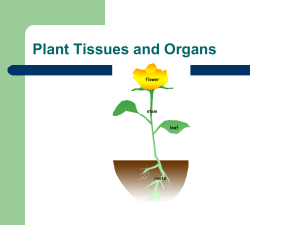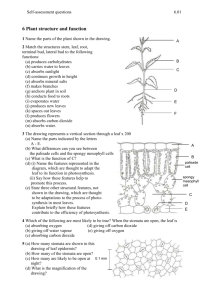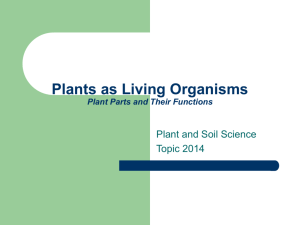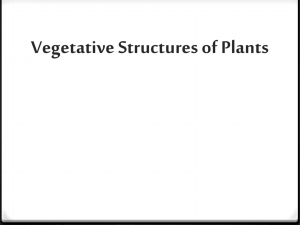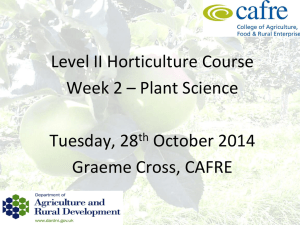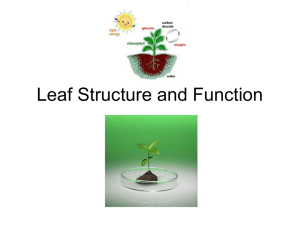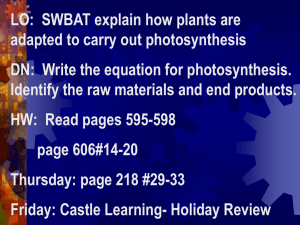Leaf structure - Teaching Biology Project
advertisement
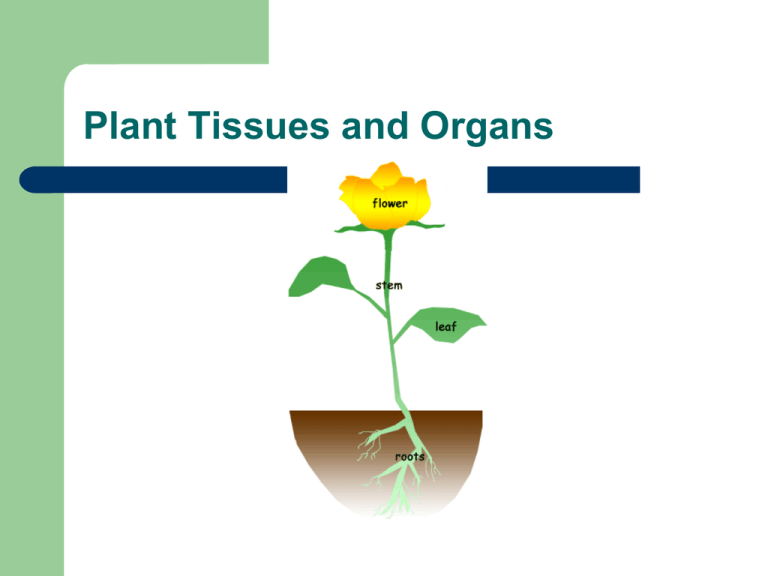
Plant Tissues and Organs Plant Tissues All plants are made up roots, stems, leaves and flowers. These structures are made up of cells These cells are not always the same in structure. They differ depending on what function they perform Some groups of cells have a supportive function. Others may be involved in photosynthesis. Cells which have a similar function, are similar in structure and form tissues. Examples of some Plant Tissues Epidermal tissue – a single layer of cells found covering the surface of the plant Some epidermal cells are specialised for perform a certain function. Examples: – – Guard cells in leaves Roots hairs in roots Vascular Tissue: Two types:Xylem – transports water from the roots via the stems to the leaves. The cells are elongated and hollow with thickened, lignified cell walls. They are arranged end-to-end. They also have a supportive function. Vascular Tissue: Phloem – transports food made in the leaves to the rest of the plant. Cells are also elongated and arranged end-toend. Supportive Tissues Supportive tissues – collenchyma and sclerenchyma Other Plant Tissues Photosynthetic Tissue – found in the leaves – the cells contain many chloroplasts. Storage and packing tissues called parenchyma. This tissue is the most common plant tissue found in plants. Plant Organs Tissues are grouped together to form a structure with a special function. This structure is called an organ. Examples of plant organs are: – Roots – Stems – Leaves – Flowers Function of the Root To anchor the plant in the soil To absorb water and nutrients from the soil for photosynthesis in the leaves Some roots store extra food – e.g. carrot Function of the Stem Support the plant Conduct water and nutrients from the roots to the leaves Conduct food (glucose) manufactured in the leaves to rest of plant Structure and Functions of a Plant Leaf Function of the Leaf Photosynthesis Gaseous exchange – – take in O2 and release CO2 during respiration take in CO2 and release O2 during photosynthesis Water Vapour can be lost from the surface of the leaf in a process known as Transpiration. Photosynthesis Energy (Sun) + CO2 (from air) + H20 (from roots) Glucose In chloroplast (chlorophyll) (Stored as starch) + O2 (Released into air) Structure of the Leaf Transverse section of a leaf phloem xylem Water-carrying cell Leaf vein Opening for CO2 and O2 and water vapour Transverse section of a leaf at cellular level Stomata: Functions The stomata are responsible for the interchange of gases for respiration and photosynthesis. The stomata allow for the loss of excess water in the form of water vapour, which also allows for cooling. Quiz: Label the parts of the leaf Stoma cuticle Palisade mesophyll Spongy mesophyll Upper epidermis Air spaces A B C D E F Brainstorm How are leaves adapted to their functions of photosynthesis and gaseous exchange? - Try to think of 7 adaptations How is the Leaf adapted to its function? Broad, flat-shape – large surface area for absorption of sunlight and carbon dioxide Thin – gases have a short distance to travel (Epidermis – 1 cell layer thick) Large air spaces between the cells of the spongy mesophyll – allow for easy passage of carbon dioxide and oxygen Waxy Cuticle (reduces water loss) Many stomata in the lower surface allow for the exchange of carbon dioxide and oxygen with the air outside (open during day, close at night) More chloroplasts in upper palisade than spongy mesophyll cells where they receive the most sunlight Branching network of veins which provide a good water supply to the cells for photosynthesis.
